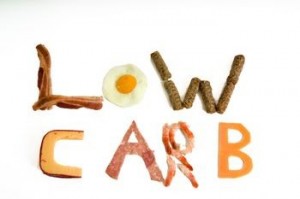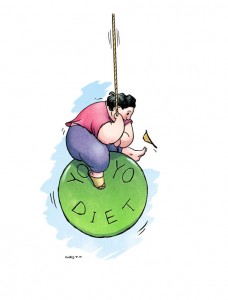 Although low-fat diets are currently being touted as the best way to lose weight and prevent many chronic illnesses, fat consumption in Western society has actually declined during the past few decades. Nevertheless, the incidence of obesity, heart disease, and many inter-related chronic illnesses continues to increase. In addition, the consumption of carbohydrates (primarily of the refined variety) has increased.
Although low-fat diets are currently being touted as the best way to lose weight and prevent many chronic illnesses, fat consumption in Western society has actually declined during the past few decades. Nevertheless, the incidence of obesity, heart disease, and many inter-related chronic illnesses continues to increase. In addition, the consumption of carbohydrates (primarily of the refined variety) has increased.
In recent years, modern thinking has leaned towards lower carbohydrate diets as being the key to losing weight and preventing the aforementioned illnesses. Moreover, it seems that the message of low-fat diets being beneficial for losing weight has become obsolete. In fact, modern diets place a greater emphasis on consuming plenty of “good” fats in place of refined carbohydrates, to stay healthy and to lose weight.
Replacing Carbohydrates with Fat
 Carbohydrates are our bodies’ primary energy source. They are designed to provide our body with readily available energy, to perform physical tasks and to fuel our brain for proper function.
Carbohydrates are our bodies’ primary energy source. They are designed to provide our body with readily available energy, to perform physical tasks and to fuel our brain for proper function.
While our brain will always need carbohydrates for optimal function, there is emerging opinion in the world of nutrition, challenging the first point: “Do carbohydrates need to be our primary energy source?”
Dr. Atkins, the founder of the infamous “Atkins diet” conducted research in this area, and proposed that we can change the primary energy source our body uses, from carbohydrates to fat. Our bodies are said to enter into a state called ketosis, which effectively means using the energy in fat to fuel daily activity in the place of the energy from carbohydrates.
How Ketosis Works
Ketosis merely means that our bodies are using fat for energy. Ketones (also called ketone bodies) are molecules generated during fat metabolism. These molecules can arise from the fat in food you have just eaten, or from the metabolism of body fat you have stored around your body. When our bodies break down fat to produce energy, most of it gets converted directly to ATP, the energy compound that our muscles need to perform contractions.
In order to put our bodies into the state of ketosis, the answer lies in modifying your daily nutritional intake. By reducing carbohydrate intake to a point where the energy from carbohydrates is exhausted, a person’s body will turn to fat for energy, thereby generating more ketones.
The Proposed Benefits of Ketosis
Diets that encourage ketosis have been successful in burning body fat. Where low-fat diets predominantly use glucose (via the breakdown of carbohydrates) as the body’s main energy source, diets based upon ketosis will encourage your body to use fat to provide energy. In addition to the fat in your diet, your body can call on the stored fat around your body for this energy. It is for this reason that ketosis usually results in body fat reduction.
The Negatives of Ketosis
 There is an assumption that, if the body is burning a lot of fat for energy, it must not be getting enough glucose. Upon switching to a low-carbohydrate diet, our body goes through a change in energy source. During this time, people can find themselves feeling tired, lethargic, and moody. This typically occurs in the first week of commencing a low-carbohydrate diet.
There is an assumption that, if the body is burning a lot of fat for energy, it must not be getting enough glucose. Upon switching to a low-carbohydrate diet, our body goes through a change in energy source. During this time, people can find themselves feeling tired, lethargic, and moody. This typically occurs in the first week of commencing a low-carbohydrate diet.
Another potential negative can arise when an individual’s energy intake is too low. Since carbohydrates are generally absent, the two macro-nutrients that remain are fat and protein. While a body in a state of ketosis will use fat for its energy source, protein can also be used to fuel their daily activities. This protein can come from the food we eat, or from the stored protein in our bodies…our muscles! Therefore, it is quite possible for an individual on a ketosis diet to enter into a catabolic state. That is, their muscle stores will waste away to provide energy to perform physical activity. Clearly, this is not an ideal state! From a weight loss perspective, muscle mass is an essential component for burning fat, as individuals with greater muscle mass have a higher metabolic rate. In addition, muscle mass is closely linked to functional and long-term health outcomes.
Furthermore, a dangerous condition called ketoacidosis can develop in those with Type 1 diabetes. The body usually avoids this state by producing insulin, but people with Type 1 diabetes are unable to produce sufficient insulin, which can lead to serious health issues.
The Verdict?
 Most low-carbohydrate diets have had both positive and negative reviews. On the positive side, many people in Western society currently consume far too many carbohydrates in their diet. The drastic reduction of carbohydrate intake often results in rapid weight loss, and may potentially lower the risk of health issues, such as diabetes and heart disease.
Most low-carbohydrate diets have had both positive and negative reviews. On the positive side, many people in Western society currently consume far too many carbohydrates in their diet. The drastic reduction of carbohydrate intake often results in rapid weight loss, and may potentially lower the risk of health issues, such as diabetes and heart disease.
On the other hand, ketosis is a relatively new concept and there remain many unanswered questions about the long-term effects on the heath of individuals who undertaking ketosis-inducing diets. Health issues may stem from the over-consumption of fat or protein, as the intake of these nutrients will significantly increase in the absence of carbohydrates.
In practical terms, the biggest issue with ketosis is that low- and no-carbohydrate diets are simply not sustainable over long periods, leading to a yo-yo effect; rapid but short-lived weight loss, followed by equal, if not additional, weight gain!
Adam Sheedy is a personal trainer at Inspire Fitness, specialising in nutrition, weight loss, sport-specific training, muscle hypertrophy, and postural correction. Adam is also currently a senior lecturer in the certificate III and IV fitness course, training others with his expertise in one-on-one training.
